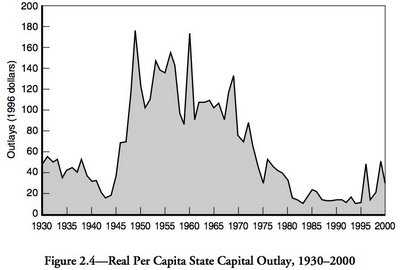On California Infrastructure
Where to start? If this was the first lecture of a class on infrastructure, I’d probably run on for an hour about the wide variety of things and problems and places the subject covers, and then close with a proposed organizational and analytical scheme for making our way the following weeks. Part of the plan would be to think about why infrastructure matters, as a behavioral and planning tool. The other part would be to consider how that matters for specific cases.
California is more than just another interesting case but permit me, below, to recycle my review of the very useful overview, Making Room for the Future: Rebuilding California’s Infrastructure, by David E. Dowall and Jan Whittington, which appears in the Winter 2005 Journal of the American Planning Association.
********
This study of state-level infrastructure planning happens to focus on California, but many of the issues and words of advice are more universal. The book has three parts: (1) a statewide status report of three major infrastructure sectors (education, transportation, and water), (2) a profile and critique of California’s infrastructure planning process, and (3) a series of recommended strategies and actions to address the litany of problems identified in parts 1 and 2.
Most of these problems will fail to surprise most Journal readers, no matter which state you happen to know best professionally. In brief, capital planning tends to be less strategic, integrated across sectors, rationally financed, effectively executed, and properly maintained than it should be, and this is costly to a state’s bottom line. The proposed remedies are also unsurprising: that capital planning should be strategic, financed by user fees (where benefits are measurable and private), and better executed and maintained. In each case, this advice is well supported by scholarship and “best practices” literatures.
The principal value of the study is in its potential to change actual practice and policy by alerting and persuading the responsible authorities. That is a formidable task, but it is difficult to imagine a more competent effort. Dowall and Whittington carefully document the state of the state, the value of infrastructure to overall economic well-being, and the reasoning behind integrated planning, funding, and management. The purpose is to point out that while infrastructure is quite costly, its benefits are larger still, and those costs can be reduced through effective planning.
The first section, a status report (chapters 2 through 5), is deliberate and to the point, identifying problems in investment and project delivery. The value here is in presenting the big picture–over time and across sectors–and the minor course adjustments that, in many cases, could reap major improvements in service delivery and cost.
At the same time, some problems are deep seated. Agencies tend to lack data, fail to plan based on realistic measures of future demand, virtually ignore (or are antagonistic to) other agencies and sectors, and have unpredictable, inefficient funding sources. None of these problems are easy to resolve. One reason is that decision making is too rarely based on sound behavioral analysis. Much infrastructure planning continues to be driven by simplistic measures–such as population trends–while not accounting for how service demand varies with such varied factors as income, age, future growth, and pricing.
Agency and sector coordination is improving, but faces major institutional and cultural obstacles. California, a state where and areas are adding population at dizzying rates, only recently required land use authorities to obtain certification of future water availability for major residential developments. The sector gaining the most political capital from this change–water agencies–resisted this requirement even more than did planning agencies. Power sharing, even if it is new power, will never be embraced.
More problematic is the issue of financing. Although the private sector has a clear connection between current investment and future profits, the public sector counterpart of investment and future service benefits remains fuzzy, particularly in an ideological environment. The trend toward user fees–if only to pay the bills–matches most arguments for rational finance. The exception is education, where poorer districts have both higher costs and fewer resources.
How well will this study work on its own terms, either to influence California’s infrastructure planning or as a guide for other areas? The documentation is a good balance of detail and message, the problems are clearly and meaningfully characterized, and the solutions are sensible. Their political feasibility, on the other hand, is not addressed and would be somewhat harder to predict.
- Published:
- Sunday, August 13th, 2006
- Author:
- randall Crane
- Topics:
- metrics, politics, public finance
Blogroll
- Becker-Posner blog
- BLDG BLOG
- Burb
- CityStates
- Curbed LA
- Cyburbia
- DemocraticSPACE
- Environmental and Urban Economics
- Freakonomics
- LA Transportation Headlines
- Peter Gordon’s Blog
- Planetizen
- The Center for Land Use Interpretation
- The Transportationist
- the urban commons
- This week’s finds in planning
- Urbanicity
Journals
- Cityscape
- environment and planning a,b,c,d
- Harvard Design Magazine
- Housing Policy Debate
- Housing Studies
- International Development Planning Review
- International Journal of Urban and Regional Research
- International Regional Science Review
- Journal of Architectural and Planning Research
- Journal of Housing Economics
- Journal of Planning Education and Research
- Journal of Planning Literature
- Journal of Regional Science
- Journal of the American Planning Association
- Journal of Urban Affairs
- Journal of Urban Economics
- Planning Theory
- Regional Science & Urban Economics
- Transportation Research Parts A,B,C,D,E,F
- Urban Studies
- World Development



1 Comment
Jump to comment form | comments rss | trackback uri